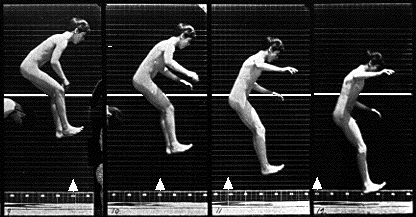
Fashioning the Body: Versions of the Citizen, the Self, and the Subject
The Evergreen State College | Fall 2007-Winter 2008
User Login |
Metropolis: Cyborgs and Performativity
Performativity, Cyborgs and Metropolis:
Cyborgs are performative, for they describe the tension between automatic responses and the site where change takes place. When the workers are first shown, they shuffle in a rectangular formation with their heads down. Even when they disperse after their shift, they remain in this structure. With the last shot of the workers, they have changed to walking in pyramid form with their heads held steady. Also, the acting style presented very stiff and automatic gesures, which blurred the distinction between the 'humans' and the "machine-man" originally named Hel. Thus, I could not help but think of performativity. The worker's constant iteration of their role in Metropolis (their clock-like movements in the body) provided instability, where the slightest change (that of Maria and the 'Machine-man' Hel) altered the actions of not only the workers but also how the character, Joh Frederson reacted to the workers. With Freder's daily frivolity in the garden, the contact with Maria provided a change in Freder's actions. I was also reminded of the opening paragraph from the Jennifer Gonzalez article where she writes, "The image of the cyborg body functions as a site of condensation and displacement. It contains on its surface and in its fundamental structure the mulitple fears and desires of a culture caught in the process of transformation." Joh Frederson uses the "machine-man" to control the workers and keep them from changing their status. In the end, however, the plan backfires and transformation happens regardless. By making Hel appear to be Maria and applying the technique of the automatic gestures, the concept of a difference between the imagined machine and the body is shown to stem from and produce one another.
Submitted by iea on Sat, 11/10/2007 - 1:58pm. iea's blog | login or register to post comments | printer friendly version
|
Who's onlineThere are currently 0 users and 1 guest online.
Events
|
|||||||||||||||||||||||||||||||||||||||||||||||||